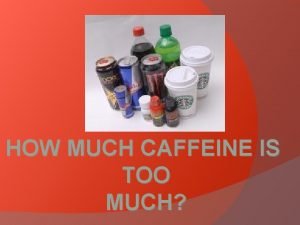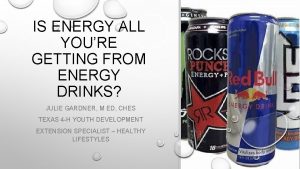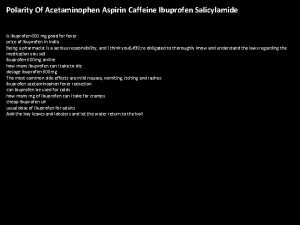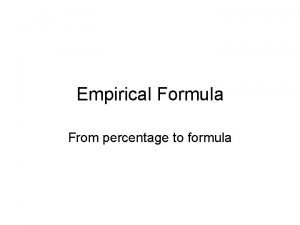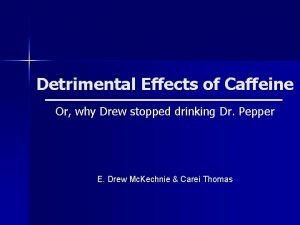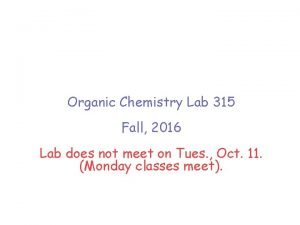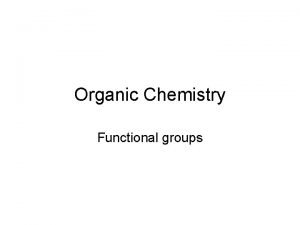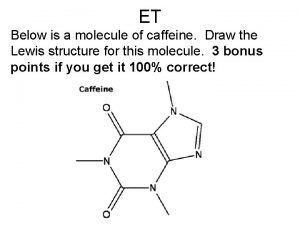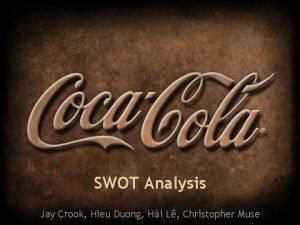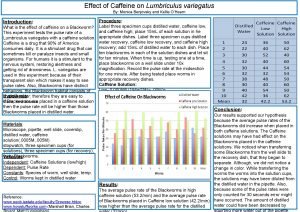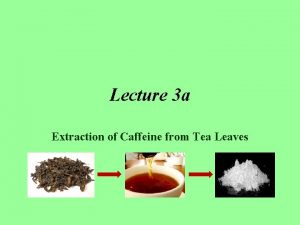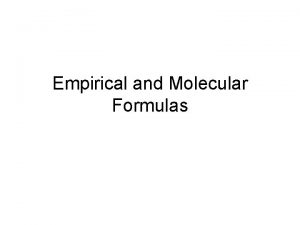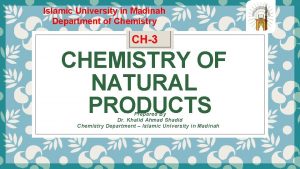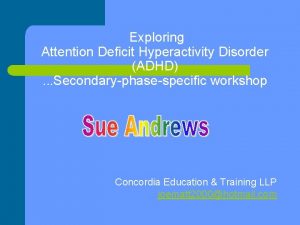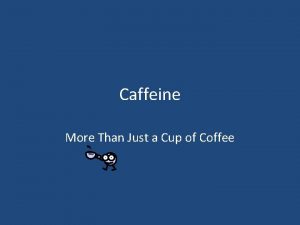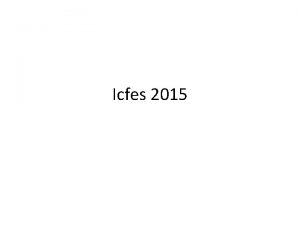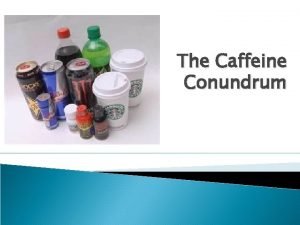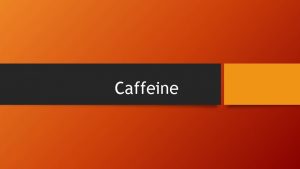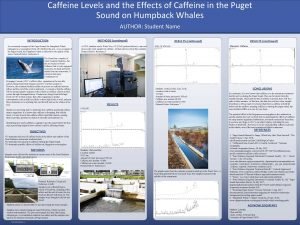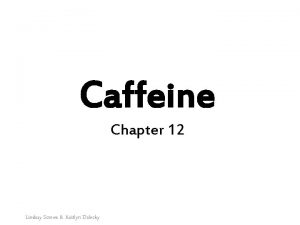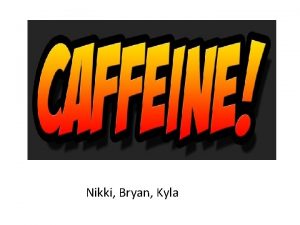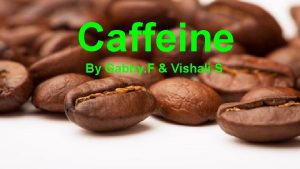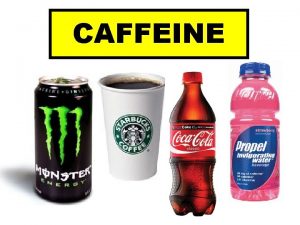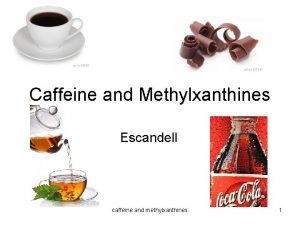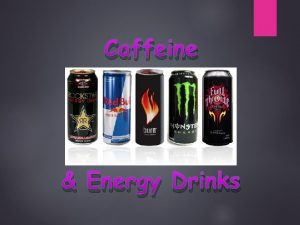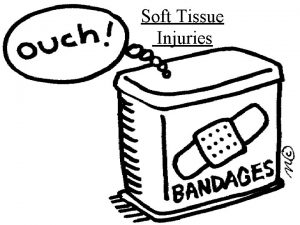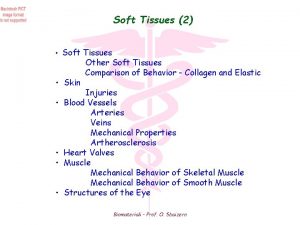How Much Caffeine Is in My Soft Drink






















- Slides: 22

+ How Much Caffeine Is in My Soft Drink? The Determination of Caffeine Content in Soft Drinks Using Gas Chromatography/Mass Spectrometry (GC/MS)

+ How Caffeine Is Ingested n Certain soft drinks, such as Pepsi, Coke, Mountain Dew) n Certain teas n Chocolate, including hot chocolate drinks n Coffee n Over-the-counter stimulants that help you stay awake, such as No. Doz, Vivarin, Caffedrine, and others Source: “Caffeine overdose: Medline. Plus Medical Encyclopedia” http: //www. nlm. nih. gov/medlineplus/ency/article/002579. htm

+ Effects of Caffeine on Humans Symptoms in adults may include: n n n n Breathing trouble Changes in alertness Confusion Convulsions Diarrhea Dizziness Fever Hallucinations n n n n Increased thirst Irregular heartbeat Muscle twitching Rapid heartbeat Sleeping trouble Urination - increased Vomiting Symptoms in babies may include: n n Muscles are very tense, then very relaxed Nausea Rapid, deep breathing Rapid heartbeat n n n Shock Tremors Vomiting Source: “Caffeine overdose: Medline. Plus Medical Encyclopedia” http: //www. nlm. nih. gov/medlineplus/ency/article/002579. htm

http: //commons. wikimedia. org/wiki/File: Main_symptoms_of_ Caffeine_overdose. png Source: Main symptoms of Caffeine overdose (See also Wikipedia: Caffeine#Caffeine_intoxication). References: Caffeine (Systemic). Medline. Plus (2000 -05 -25). Archived from the original on 2007 -02 -23. Retrieved on 2006 -08 -12. +

+ What do the letters GC/MS stand for? n. Gas n. Chromatography n. Mass n. Spectrometry

+ What is GC/MS used for? n If you want to identify a compound, you take a solid sample and dissolve it in a solvent. The gas chromatography machine vaporizes the mixture into gas phase. The gas particles are then sent through a mass spectrometer, which separates ions by their mass-tocharge (m/Z) ratios. n Basically, you can analyze a very small sample of a compound and identify it using GC/MS. n It is used to identify pesticides, drugs, accelerants (like in arson investigations), etc.

+ What is GC/MS? http: //www. dps. state. ia. us/DCI/lab/drugidentification/gas_chromatograph. shtml

GC/MS + Courtesy of: http: //qb 3. berkeley. edu/msf/images/GCMS_500. jpg Access GC/MS machine at U. C. Berkeley n Open

+ Electron Impact (EI) Technique GC/MS machine at U. C. Berkeley Mass Spectrometry Facility Your soft drink samples will be analyzed using EI on this machine.

+ Your Sample The machine is controlled by a computer. The technician puts the samples in the tray and the machine automates the rest. First, your sample is taken up by the Autosampler from your vial.

+ Your Sample Next, the machine injects your sample quickly into the GC chamber, where it will be heated into the gas phase.

+ Your Sample The filament in the ion source emits the generates electrons that ionize the sample molecules.

+ Concepts that Will Help with the Separation Techniques n density n solubility n polarity

+ The Separation Process ① Combine 1 m. L of your soft drink, 100 µL of deuterated caffeine, and 0. 15 g of sodium carbonate into a capped test tube. Shake gently to dissolve all of the sodium carbonate. ② Pipet 500 µL of rubbing alcohol into the test tube. Cap and invert gently twice, venting to relieve pressure as needed. Let test tube stand for 5 minutes. ③ Withdraw the top isopropanol layer from the test tube and keep extracts in a beaker.

+ The Separation Process ④ Repeat washings twice more: adding 500 µL of rubbing alcohol, inverting, waiting 5 minutes, and withdrawing the upper isopropanol layer each time. ⑤ Combine all isopropanol extracts into the same beaker. Add about 0. 10 g sodium sulfate to the extracts to absorb any leftover water. ⑥ Withdraw 1 m. L of the isopropanol extracts (being careful not to take up any sodium sulfate) and pipet into a GC/MS vial for analysis.

+ Gas Chromatogram n. A gas chromatogram shows the retention time, or how long it takes for a compound separates from a sample. n The gas chromatogram also shows relative abundance, or how much of the compound is present in the sample. Abundance is based on the concentration; so the higher the concentration, the higher the abundance reading of an ion of the compound. The GC/MS machine can usually detect a minimum concentration of 1 ppb, depending on detection method. n Settings most often can be changed according to temperature and time. n See the next slide for the gas chromatogram for caffeine.

+ Gas Chromatogram n. A gas chromatogram display “peaks” telling you how much of a substance is in your sample. Relative abundance (based on concentration) is on y-axis and retention time (each compound is unique and can be identified from it) is on x-axis.

+ Gas Chromatogram Analysis n Next, we will select for caffeine (MW 194) and deuterated caffeine (MW 197) by their masses.

+ Gas Chromatogram Analysis n Finally, we integrate (find area) each of the peaks. We will use the areas to calculate caffeine content.

+ Bibliography n "Caffeine Content of Drinks - How Much Caffeine in Coffee, Soft Drinks, Tea - Amount of Caffeine. " wilstar. com. Wilstar. n. d. Web. 13 June 2011. n "Caffeine Content of Drinks. " energyfiend. com. Energy Fiend, n. d. Web. 20 June 2011. n "Caffeine Lab Pre/Post-Lab Activities. " departments. oxy. edu/tops/. Occidental College. 10 Apr. 2006. Web. 14 June 2011. n "Caffeine from Soda Preparation. " studyblue. com. Study Blue. n. d. Web. 14 June 2011. n "Caffeine in the diet: Medline. Plus Medical Encyclopedia. " nlm. nih. gov. Medline Plus. 23 June 2011. Web. 23 June 2011. n "Caffeine overdose: Medline. Plus Medical Encyclopedia. " nlm. nih. gov. Medline Plus. 23 June 2011. Web. 23 June 2011. n Hill, Devon W. , Mc. Sharry, Brian T. , and Trzupek, Larry S. "Quantitative Analysis by Isotopic Dilution Using Mass Spectroscopy: The Determination of Caffeine by GC-MS. " Journal of Chemical Education 65. 10 (1988): 907 -910. Print. n Horning, Marjorie G. , Boucher, E. Ann, Stafford, Michele, and Horning, Evan C. . "A rapid procedure for the isolation of drugs and drug metabolites from plasma. " Clinica Chimica Act, 37. 3 (1972): 381386. Web. n Laswick, Patty Hall and Laswick, John A. "Caffeine and benzoic acid in soft drinks. " Journal of Chemical Education 49. 10 (1972): 708. Print. n Yang, Min J. , Orton, Maureen L. , and Pawliszyn, Janusz. "Quantitative Determination of Caffeine in Beverages Using a Combined SPME-GC/MS Method. " Journal of Chemical Education 74. 9 (1997): 1130. Print.

+ Special thanks to… n Industry Initiatives for Science and Math Education (IISME) Santa Clara, CA n Syn. BERC —University of California, Berkeley n National Science Foundation (NSF) n Drs. Ulla Andersen, Zhongrui Zhou, Rita Nichiporuk, Tony Iavarone — Mass Spectrometry Facility, University of California, Berkeley n Dante Valdez — College of Chemistry, University of California, Berkeley

+ Credits n Jonathan C. Fong — AP Chemistry Teacher, Lowell High School, San Francisco, CA n Dr. Ulla N. Andersen — Facility Manager, QB 3/Mass Spectrometry Facility, University of California, Berkeley n Evan R. Williams — Professor of Chemistry, University of California, Berkeley
 Decaffeinated hot chocolate
Decaffeinated hot chocolate Energy drink caffeine chart
Energy drink caffeine chart Caffeine uses
Caffeine uses Which soft drink is good for health
Which soft drink is good for health How much is too much plagiarism
How much is too much plagiarism To whom much is given much is expected meaning
To whom much is given much is expected meaning Polarity of aspirin acetaminophen ibuprofen caffeine
Polarity of aspirin acetaminophen ibuprofen caffeine What is the empirical formula
What is the empirical formula Caffeine has a molecular weight of 194
Caffeine has a molecular weight of 194 Organic chemistry laboratory ch 2540 manual
Organic chemistry laboratory ch 2540 manual Propyl acetate functional group
Propyl acetate functional group Decomposition reaction example
Decomposition reaction example Caffeine go
Caffeine go John pemberton
John pemberton Effects of caffeine on blackworms
Effects of caffeine on blackworms Solubility of caffeine in different solvents
Solubility of caffeine in different solvents Lewis moon snail
Lewis moon snail Empirical formula of caffeine
Empirical formula of caffeine Herzig meyer method
Herzig meyer method Caffeine and adhd
Caffeine and adhd Does cold stone coffee ice cream have caffeine
Does cold stone coffee ice cream have caffeine Elephant riding in phuket icfes
Elephant riding in phuket icfes Do you fancy going away for the weekend
Do you fancy going away for the weekend
